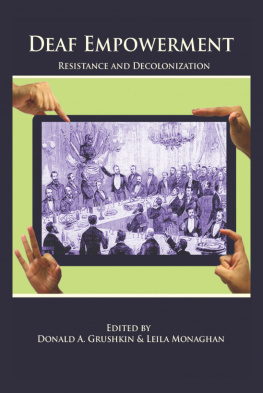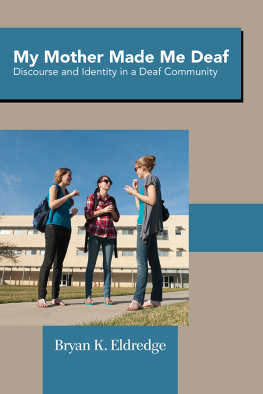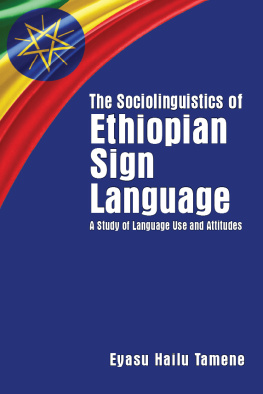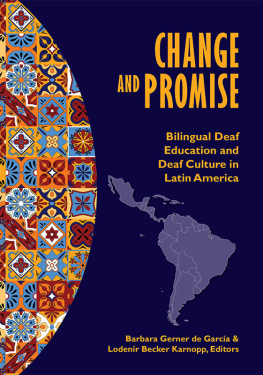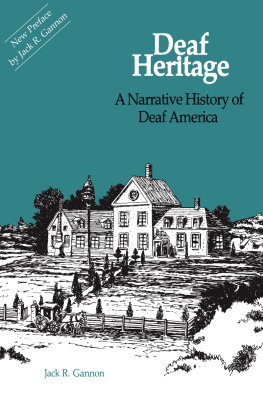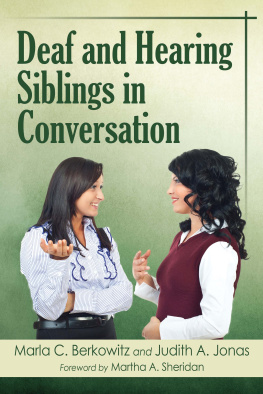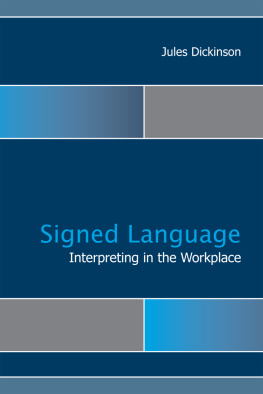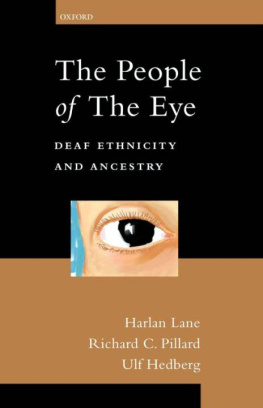Reading Between the Signs
WORKBOOK
Reading Between the Signs WORKBOOK
A Cultural Guide for Sign Language Students and Interpreters
Anna Mindess
Published by Intercultural Press, a division of Nicholas Brealey Publishing. For information contact:
Intercultural Press | Nicholas Brealey Publishing |
a division of Nicholas Brealey Publishing | 35 Spafield Street, Clerkenwell |
100 City Hall Plaza, Suite 501 | London, EC1R 4QB, UK |
Boston, MA 02108 | Tel: +44-(0)207-239-0360 |
Tel: 617-523-3801 | Fax: +44-(0)207-239-0370 |
Fax: 617-523-3708 | www.nicholasbrealey.com |
www.interculturalpress.com |
2004 by Anna Mindess
All rights reserved. No part of this publication may be reproduced in any manner whatsoever without written permission from the publisher, except in the case of brief quotations embodied in critical articles or reviews.
Printed in the United States of America
10 09 08 07 06 2 3 4 5 6
ISBN-10: 1-931930-03-1
ISBN-13: 978-1-931930-03-1
For my daughter Lila,
to further her journey on the intercultural path.
CONTENTS
ACKNOWLEDGMENTS
I want to thank my husband Armand and my daughter Lila for their patience through another writing process, with my books and notes inevitably spread out all over the house. Thanks to my father for his support and a bit of invaluable detective work as well.
I am grateful to Celene de Miranda, Eileen McCaffrey, Nancy Pfanner, Elizabeth Ann Prinz, Theresa Smith, and Betsy Winston for their letters of support at a critical time in the development of the workbook. My heartfelt thanks to Toby Frank for her efforts in getting the workbook published.
My appreciation goes to Arden Wong and Orkideh Sassouni, librarians at the Deaf Services Center of the San Francisco Main Library, for their cheerful assistance.
A big thank you to Tom Holcomb for checking my descriptions of Deaf culture and to Patricia Lessard for her encouragement and for pilot testing some of the exercises with her class at Ohlone College. Special thanks to two of her students, Mary J. Edwards and Cherise J. Farris, for their input and suggestions.
It was again a pleasure to have Judy Carl-Hendrick as my sensitive and insightful editor at Intercultural Press.
And once more, I owe a debt of gratitude to my dear friend, Margaret Dorfman. I couldnt have finished this workbook without her support and encouragement. Margaret, thanks for being my writing gardener; you always know whether my words need watering or weeding.
SECTION
I
INTRODUCTION: UNPACKING YOUR CULTURAL BAGGAGE
The real job is not to understand foreign culture but to understand our ownall one ever gets from studying foreign culture is a token understanding. The ultimate reason for such study is to learn more about how ones own system works.
Edward T. Hall
The Silent Language
Each of us carries around a type of baggage that cannot be checked at the airport. Because it is invisible, we may not even be aware of its existence. What does this set of hidden luggage contain? Our cultural inheritance of values, attitudes, and beliefs, which, although we may not want to admit it, still influences our daily behavior and the way we interact with others. Stopping to unpack and examine the contents of this baggage will not only make us more culturally sensitive interpreters and sign language students but may also improve our dealings with many others who carry around their own sets of cultural bags.
In 1999, Reading Between the Signs: Intercultural Communication for Sign Language Interpreters was published. I am humbly gratified to say that it has been widely adopted as a textbook, not only in interpreter preparation programs but in American Sign Language (ASL) and Deaf culture classes as well. Since that time, I have presented many workshops on the material it covers, either alone or in collaboration with my esteemed Deaf colleagues and consultants on the book, Dr. Thomas K. Holcomb, Daniel Langholtz, and Priscilla Moyers. In my travels I have found students eager to grapple with the cultural issues raised in the book. I have also come to the realization, although I am certainly not the first to do so, that there are two paths to effective learning: the knowledge acquired through books and instructors and the wisdom gained from personal experience.
With the latter approach in mind, I present this book of exercises, designed not so much for students to regurgitate material from the book but to interact with it and in the process, I hope, to embark on a brief journey of self-discovery. The order of the exercises mirrors the order of material presented in Reading Between the Signs, from an overview of culture in general to dealing with specific interpreting challenges. The focus of the workbook, however, is slightly different. Here you will find more emphasis on developing and practicing an open-minded intercultural perspective and on identifying elements of your own cultural character.
Throughout my years of interest in the intersection between the fields of intercultural communication and sign language interpreting, my favorite moments have been the aha experiences when something I have read or heard has opened my eyes about a real-life misunderstanding. Those moments occur, not only among the clients for whom I am interpreting but also between myself and others. It is always unsettling to realize that no amount of reading and preparation can prevent the feeling of momentary disequilibrium produced by seeing things from a different cultural angle.
Here is a personal example, one of my own aha experiences. I was fortunate to have the help of Dr. Thomas Holcomb, a highly respected Deaf educator, when I wrote Reading Between the Signs. I discovered, however late, that I had originally introduced myself to Tom incorrectly. We knew each other only slightly the day I met him at his office. I told him about my book project and explained who the publisher would be, and asked if he would be interested in working with me. He answered with a cool Perhaps and asked to read some of my completed chapters. It was only later, after we had started working together, that I became aware of my error. One day, while discussing definitions of culture, Tom proposed that we use Carol Paddens definition. I agreed and casually mentioned that I knew Carol Padden because she had been one of my thesis advisers.
You know Carol Padden! Why didnt you tell me before? Tom demanded heatedly.
For a moment I froze. I remember thinking, Whats the big deal? You seem to think I owed you the information! Then suddenly it clicked. One of the themes of our chapter on Deaf culture was the importance of information sharing, which is exemplified in many cultural behaviors, including introductions. I finally made the connection!
You mean I should have told you about Carol the first day when we met in your office? I ventured.
Yes! came the strong reply.
What followed was a stimulating discussion in which I explained to Tom my difficulty in carrying out what is considered appropriate behavior for hearing people during introductions; that is, mentioning names of well-known Deaf people one has had connections with in order to show he or she can be trusted. Because of the ingrained disapproval of name-dropping in American culture, I would still feel I was being rude to do so. Tom understood my dilemma, and we discussed several options for satisfying both cultural pulls.
Next page

